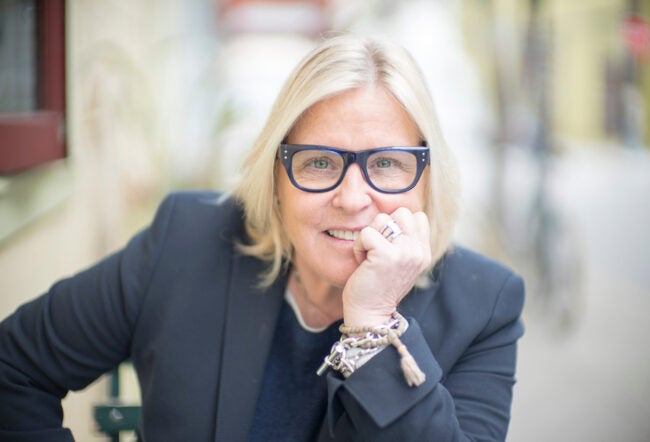In recent years, filmmakers and business executives from the United States, South Asia, and Europe have shown a growing interest in the Middle East and North Africa (MENA) region, not only as a potential market but also as a wellspring of talent and inspiration. Major motion pictures — such as Syriana, The Kingdom, The Hurt Locker, Transformers: Revenge of the Fallen, and In the Valley of Elah — were all filmed in the MENA region and have since achieved blockbuster success. Since the early 1940s, Western film directors have realized that this region — defined by idiomatic histories, ancient cultures, and remarkable landscapes — represents a unique and vibrant cinematic opportunity.
Egyptian Media Production City
Egypt has long been the center of modern media production in the Arabic-speaking world. Its vibrant music, television, and film industries have traditionally dominated the transnational Arab media market. The late 1990s saw a major expansion of media production in Egypt and the rest of the Arab world — the result of the launch of the first communications satellites in the region, with the aim of reaching a transnational audience of consumers through the proliferation of home satellite dishes. In 1996, Nilesat was established to operate future communications satellites that would be launched for the purpose of broadcasting media in the region. The following year, the Egyptian Radio & Television Union and the Ministry of Information proposed to create a special zone for media production that would host studios for the television channels broadcast by Nilesat.
In 2000, the Ministry approved the creation of the Egyptian Media Production City (EMPC), 48% of which is owned by the Ministry and 52% by banks and primarily local private investors. Presently, EMPC contains a variety of facilities, including presses for print media, studios and sets for television programs, an academy of media sciences, advertising services, and cinema production capabilities. This city represents the first deliberate attempt to create a media industry cluster in the Middle East. To attract international investors, it has operated as a free zone, exempting all project imports from taxes, custom duties, and tariffs. Thus far, EMPC has been able to attract television, print, and film productions from across Egypt and around the world, using a number of arrangements ranging from facility rental agreements to profit-sharing and co-production schemes.
EMPC’s Cinema City plays a major role in producing Egyptian cinema. Its administrators also seek to attract regional and global production studios. To that end, many of EMPC’s advantages have been crafted specifically to draw non-domestic business — in particular, Western film production, which is usually based in Morocco and Tunisia.
Despite vast pools of talent in all fields of the film and television industry and the third largest production facilities in the world after the United States and India, EMPC has struggled to attract major international film production houses. Over the past 60 years, roughly 36% of Western films set in Egypt were actually filmed there. Many of the others were filmed in Morocco or Tunisia. If one takes into account the total number of movies set in locales similar to those found in Egypt, the percentage is even lower. Youssef Rizkallah, renowned Egyptian film critic and head of international cooperation at EMPC, notes, “We have learned from institutions such as the British Columbia Film Commission which has been very successful in attracting film studios by offering tax incentives. Not only does EMPC offer incentives to studios seeking to control production costs, but the city offers pre- and post-production capabilities, historical shooting areas, and capacity to create customized sets.”
Yet EMPC continues to experience problems in attracting foreign film production. The four major challenges are the hesitance of producers to try new and untested filming centers, the bureaucratic hurdles foreign studios face when trying to film on site in Egypt, the lack of a prominent film commission in the country, and the effects of regional security issues on insuring film productions. Given the logistical requirements and seasoned expertise required to support large movie productions, many producers and directors prefer shooting in locations that already have proven track records. This risk aversion creates an inertia that does not favor new media industry clusters such as EMPC. Furthermore, although film producers are often attracted to Egypt’s many historical locations, the procurement of permits to use these sites can be problematic.
For example, with EMPC’s assistance, director Michael Bay sought to film Transformers: Revenge of the Fallen (2009) on site at the Pyramids and Luxor. Although Bay describes the experience as “remarkably smooth,” permission to film at these locations was delayed by the Ministry of Culture. Rizkallah attributes such bureaucratic problems to the lack of a dedicated film commission headed by a prominent government official or public figure: “A film commission would signal to outsiders a constructive climate for international filming [in Egypt], and if it is headed by a prominent public official, it would also foster confidence in the government’s willingness to maintain this climate.”
Furthermore, regional security issues have made it difficult for production companies to obtain the necessary insurance coverage to film in Egypt. Most recently, Gavin Hood, director of the blockbuster movie Rendition, was forced to change the location of his CIA-themed drama from Egypt to Morocco after being denied insurance coverage. To avoid these complications, many major production houses in Hollywood have deliberately avoided Egypt, opting for more accessible and affordable conditions for their projects.
As Egypt continues to struggle with internal problems, competition in the MENA region for the international film business is becoming increasingly intense. Countries are now competing aggressively to attract major motion picture productions from Hollywood, Bollywood, and Europe.
The film industry in Jordan recently received accolades for its role in the filming of The Hurt Locker, which won the Oscar for Best Picture at the 2010 Academy Awards. Kathryn Bigelow, the director, has stated on several occasions that shooting in Jordan was a great experience and that the Jordanian actors and crew (around 150 total, according to the Royal Film Commission in Jordan) involved in the movie were consummate professionals.
Dubai Media City
The United Arab Emirates (UAE), the Middle East’s rising giant in the film industry, has grabbed the attention of media companies around the world. Of the five media cities established there over the past 10 years, Dubai Media City (DMC) is the first and foremost industry cluster. Founded in 2001, it is the main media entity of TECOM Investments, a company focusing on the information technology and telecommunications sector. It is a subsidiary of Dubai Holding, which is owned by the emir of Dubai, Sheikh Mohammed bin Rashid Al Maktoum. Operating under the mission statement of being involved with “anything and everything to do with media,” DMC was created with the clear aim of making Dubai the media industry hub of the region.
Its status as a government property has not hindered its ability to grow rapidly. To date, more than 1,300 companies from over 70 countries are registered there. This success is rooted in DMC’s convenient location in a cosmopolitan city and international trade hub, its tax-free status and its multibillion dollar media infrastructure. In addition, DMC covers the entire media value chain — from consumer research to post-production services–for all companies located in this free zone.
Recognizing the success of DMC and the opportunity to provide more targeted offerings, Dubai Holding launched Dubai Studio City in 2005. This city is a 22 million-square-foot production cluster with state-of-the-art filming and broadcasting facilities. Umran Shah, development manager at DMC, notes that “Dubai Studio City was created to attract film production away from traditional Middle Eastern film production countries, such as Morocco,” in addition to attracting lucrative Bollywood film productions, which currently make up the majority of films shot in Dubai. Dubai Studio City offers offices, post-production studios, sound stages, workshops, warehouses, and back lots. Registered companies are also able to build their own studios and facilities on custom-sized plots. As Dubai Studio City executive director Jamil Al Sharif notes, “[Dubai Studio City] will offer anything that is needed to facilitate excellent production.” Furthermore, it was also designed with the aim of promoting domestic film production among the local Emirati population. These efforts have culminated in the production of the first UAE-based films, such as City of Life, a 2009 drama by Emirati director Ali F. Mustafa.
Despite the rapid growth of the film industry in Dubai, movie-making has had its share of controversy. The National Media Council of the UAE governs all media productions in the country. This entity, based out of the federation’s more conservative capital, Abu Dhabi, ensures that any film production follows the country’s code of conduct. With taboos surrounding religion, sex, and politics, many Western studios have been hesitant to bring their productions to the UAE. The most recent example is exemplified by the decision of the Sex in the City 2 producers to film their Abu Dhabi-based plot in Morocco, without ever approaching the UAE’s National Media Council.
There is also a general wariness by the Council to green-light the filming of Western movies following the political controversy caused by Syriana and The Kingdom, filmed in Dubai and Abu Dhabi, respectively, which dealt with topics such as immigration, labor rights, and extremism in the Middle East. For example, although Syriana was filmed in Dubai, the film was censored before being released into the local market, resulting in the excision of scenes that portrayed the mistreatment of South Asian workers by local authorities in an unnamed Gulf State, an image of the late Saudi King Fahd bin Abdul Aziz Al Saud, and a reference to the multinational construction conglomerate, the Saudi Binladin Group. Aleem Jumaa, head of Dubai’s censorship office, notes, “We would never allow anything that is disrespectful to the country or the president, causes security problems, insults religions, exhibits immorality like nudity or promotes vices like alcohol and drugs.”
Unseating the Industry Leader
Morocco and Tunisia have long-established track records with the film industry in the West. Both countries are recognized as failsafe locations that have hospitable conditions devoid of unnecessary administrative and governmental complications. Morocco has become the favorite location for notable directors like Ridley Scott, who has shot a number of films there, including Black Hawk Down, Gladiator, and Kingdom of Heaven. The governments in Morocco and Tunisia have implemented regulations, established councils, and allocated significant funds to ensure that their countries remain attractive markets for filmmakers around the world.
For decades, Morocco has received the lion’s share of interest from foreign production firms, earning an estimated US$50-US$70 million annually. A combination of factors has led to Morocco’s attractiveness as the preferred film production center for Western studios.
Morocco has a more developed industry for supporting the production of movies, from the elaborate to the more mundane, at a lower cost than other locales in the region. There are a number of ready-made sets that the country has accumulated over the decades, capable of depicting just about any scene in the Middle East — from the Pyramids in Giza to the Ka’aba in Mecca. This offers directors and producers great flexibility by allowing them to avoid the expense of traveling to shoot multiples scenes on location for the same movie.
In addition, a stable and experienced labor pool exists in Morocco. On average, more than 600 foreign films receive authorization each year, using local talent as extras as well as technicians, grippers, and post-production specialists. These individuals are multilingual and experienced workers who have worked with foreign production teams on a consistent basis. In fact, the country claims their local movie production labor force is the most competent and cost-effective in the region. To further add efficiency to this labor market, the Moroccan Cinema Center even publishes labor rates and standard contract conditions to facilitate speedy contracting.
Morocco boasts a far more accommodating atmosphere for foreign film production companies than anywhere else in the MENA region, with far less censorship and regulation of content. In contrast, we have seen how newer regional entrants into the international film business, like the UAE, have shied away from certain films if the content transgresses “cultural norms,” which are sometimes ill-defined.
Morocco’s seriousness in supporting its media industry is evidenced by the ministerial-level Moroccan Cinema Center, which oversees the sector. By direct coordination through this body, directors and film producers can, for example, gain access to use as props almost any asset the Moroccan government possesses. The MCC even provides foreign production companies with the request forms. The actual logistics needed to accomplish these tasks are administered by private companies licensed by the MCC.
No other place in the Middle East region demonstrates such a long-lived legacy of support for foreign film production. Countries like the UAE and Egypt have tried to attract foreign productions through their media cities. But, thus far, these industry clusters have been unable to replicate the deep and widespread support for the industry witnessed in Morocco. Given the range of challenges facing the Middle East’s recently established media cities in entering the filming industry, one may conclude that Morocco and Tunisia will continue to be the primary centers of Western film production in the region for the foreseeable future.
This article was written by Arya Abedin, Andrew DeBerry, Brent Dial, Matthew Sunderland and Omar Taha, members of the Lauder Class of 2012.



